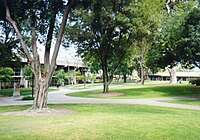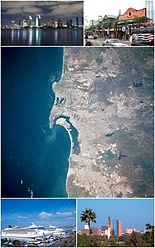
Chula Vista is a city in San Diego County, California, United States. It is the second-most populous city in the San Diego metropolitan area, the seventh-most populous city in Southern California, the 15th-most populous city in the state of California, and the 82nd-most populous city in the United States. The population was 275,487 as of the 2020 census, up from 243,916 as of the 2010 census. It is located in the South Bay, about halfway—7.5 miles (12.1 km)—between the two downtowns of the San Diego–Tijuana region. Chula Vista is named for its scenic location between San Diego Bay and coastal mountain foothills.

Imperial Beach is a beach city in San Diego County, California, with a population of 26,137 as of the 2020 United States census. It is in the South Bay area of San Diego County, 14.1 miles (22.7 km) south of downtown San Diego and 5 miles (8 km) northwest of downtown Tijuana, Mexico. Imperial Beach is the southernmost city in California and the West Coast of the United States.
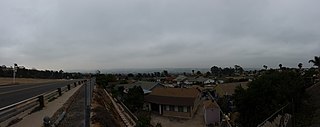
San Ysidro is a district of San Diego, California, immediately north of the Mexico–United States border. It neighbors Otay Mesa West to the north, Otay Mesa to the east, and Nestor and the Tijuana River Valley to the west; together these communities form South San Diego, a practical exclave of the City of San Diego. Major thoroughfares include Beyer Boulevard and San Ysidro Boulevard.
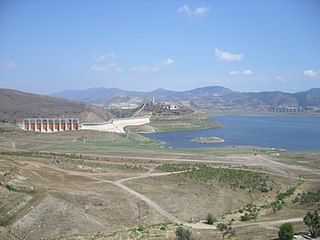
The Tijuana River is an intermittent river, 120 mi (195 km) long, near the Pacific coast of northern Baja California state in northwestern Mexico and Southern California in the western United States. The river is heavily polluted with raw sewage from the city of Tijuana, Mexico.

Sweetwater Union High School District (SUHSD) is a school district headquartered in Chula Vista, California. The union high school district serves over 42,000 high school-aged students and over 32,000 adult learners. Overseen by a five-member board of trustees, the district operates 14 high schools ; 11 middle schools; 4 adult schools; a regional occupational program (ROP); and special education.
Otay Mesa is a community in the southern exclave of San Diego, California, just north of the U.S.–Mexico border.

The Sweetwater River is a 55-mile (89 km) long stream in San Diego County, California. From its headwaters high in the Cuyamaca Mountains, the river flows generally southwest, first through rugged hinterlands but then into the urban areas surrounding its mouth at San Diego Bay. Its drainage basin covers more than 230 square miles (600 km2), all of it within San Diego County.
California's 52nd congressional district is a congressional district in the U.S. state of California. The district is currently represented by Democrat Juan Vargas.
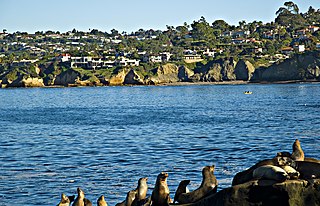
San Diego–Tijuana is an international transborder agglomeration, straddling the border of the adjacent North American coastal cities of San Diego, California, United States, and Tijuana, Baja California, Mexico. The 2020 population of the region was 5,456,577, making it the largest bi-national conurbation shared between the United States and Mexico, and the second-largest shared between the US and another country. The conurbation consists of San Diego County, in the United States and the municipalities of Tijuana, Rosarito Beach (126,980), and Tecate (108,440) in Mexico. It is the third most populous region in the California–Baja California region, smaller only than the metropolitan areas of Greater Los Angeles and the San Francisco Bay Area.
South San Diego is a district within San Diego, and is in the larger South Bay region of southwestern San Diego County, California. It is a practical exclave of San Diego, having no land connection with the rest of the city. It is the only part of the city which borders Mexico. South San Diego includes four of the city's official community planning areas: Otay Mesa, Otay Mesa-Nestor, San Ysidro, and the Tijuana River Valley.

California's 18th senatorial district is one of 40 California State Senate districts. It is currently represented by Democrat Steve Padilla of Chula Vista.

San Diego County, officially the County of San Diego, is a county in the southwest corner of the U.S. state of California, next to the Mexican border. As of the 2020 census, the population was 3,298,634; it is the second-most populous county in California and the fifth-most populous in the United States. Its county seat is San Diego, the second-most populous city in California and the eighth-most populous in the United States. It is the southwesternmost county in the 48 contiguous United States, and is a border county. It is home to 18 Indian reservations, the most of any county in the United States. There are 16 military installations of the Navy, Marine Corps, and Coast Guard in the county.
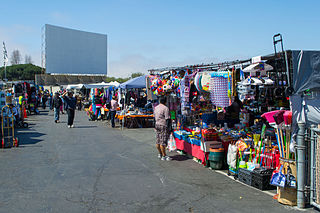
Nestor is a residential neighborhood in the southern section of San Diego, California, part of the Otay Mesa-Nestor community planning area. It neighbors Palm City and Otay Mesa West to the east, Egger Highlands to the north, San Ysidro to the southeast and the Tijuana River Valley to the south. Major thoroughfares include Coronado Avenue, Saturn Boulevard, Hollister Street, and Tocayo Avenue.

Egger Highlands is a residential neighborhood in the southern section of downtown San Diego, California. It neighbors Palm City and Nestor to the east, San Diego Bay to the north, Imperial Beach to the southwest and Chula Vista to the northeast. Major thoroughfares include Coronado Avenue, Saturn Boulevard, and Palm Avenue.
Palm City is a neighborhood in the southern section of San Diego, California. Its neighbors are Otay Mesa West to the south and east, Egger Highlands and Nestor to the west, and Chula Vista to the north. It also serves as a gateway to the beach cities of Imperial Beach, and Coronado, by way of the Silver Strand isthmus, due to it being where California State Route 75 meets Interstate 5. Major thoroughfares include Coronado Avenue, Hollister Street, Beyer Boulevard, and Palm Avenue.
Transportation in San Diego–Tijuana occurs by various means. Though, in the four cities of San Diego, Tijuana, Tecate, and Rosarito Beach, the automobile serves as most important means of transportation. The international metropolitan region maintains an intricate highway infrastructure. As a large metropolitan area in Western North America, many roadways, including Interstates, State Routes, and Mexican Federal Highways, hold a terminus in the area. These roads have grown accustomed to support the masses of the commuting populace within the international region and are constantly being expanded and/or renovated. Transportation is a crucial issue in the metropolitan area. The streets and highways of the region affect environmental health and have influence over the degree of regional connectivity. Binational discussions about coordinating public transportation across the border are currently underway. San Diego–Tijuana is the site of two major international airports and numerous regional airports. It is also the site of the Port of San Diego and miles from the nearby Port of Ensenada.
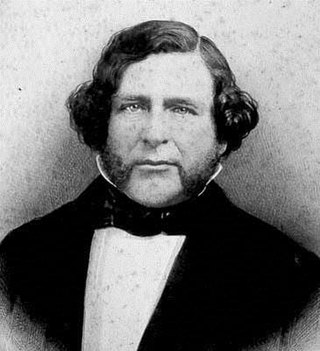
Rancho Melijo, or Milijo, was a Mexican land grant rancho, named after a local Kumeyaay village. It was later called Rancho La Punta for the location of the Arguello family ranch house, on a point of hills overlooking the south end of San Diego Bay, north of the Otay River and east of where the river entered the south bend of the bay. It was granted by Governor José Figueroa in 1833 to Santiago E. Argüello.

Goat Canyon also known as Cañón de los Laureles, begins in Tijuana, Mexico, and ends in the United States just north of the Mexico–U.S. border. The canyon is formed by Goat Canyon Creek, which receives water and other runoff from areas south of the border. Most of the canyon and its watershed lies within Baja California.



